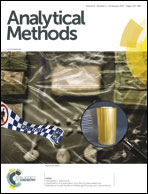Evaluation of energy dispersive scanning electron microscopy and X-ray fluorescence techniques for analysis of compost quality
Abstract
Composting is a traditional method of municipal solid waste recycling and still in practice in most municipal authorities. Since municipal solid wastes are generated from a variety of activities, many toxic materials like lead, chromium, mercury, etc., enter into municipal solid waste streams. Hence, it is very essential to analyze the quality of compost produced from municipal solid waste before its use in the agricultural sector to avoid its adverse effects on crops. The characterization of compost quality is not possible through a single technique and the most widely used techniques like Atomic Absorption Spectroscopy (AAS) and Inductively Coupled Plasma-Mass Spectroscopy (ICP-MS) methods are complex, have higher possibility of sampling errors and are less economic. In the present study, the toxicity level of municipal solid waste compost is evaluated through Energy Dispersive X-ray Fluorescence (ED-XRF) and Scanning Electron Microscopy (SEM-EDS) techniques and compared with the results obtained from AAS. The results of the XRF method were concordant with those of AAS. The XRF and SEM-EDS techniques are non-destructive, economic, able to estimate the concentrations of several metals present in samples simultaneously, time saving, and found to be much more significant in the evaluation of compost quality.


 Please wait while we load your content...
Please wait while we load your content...